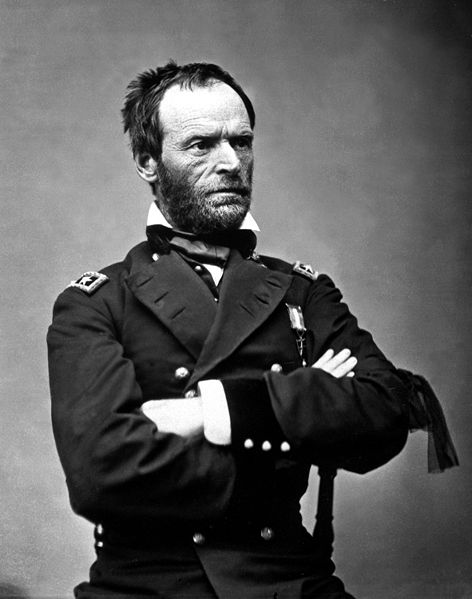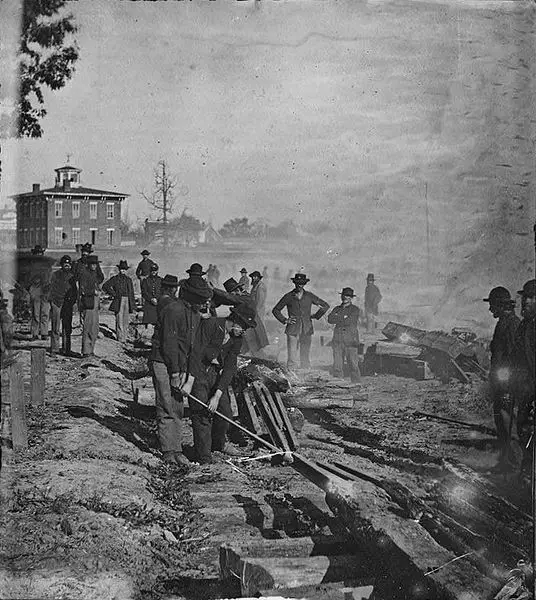Sherman’s March to the Sea, part of the Atlanta-Savannah Campaign, was one of the most important, infamous, and controversial military operations from the American Civil War (1861-1865). The March was intended to help end the fighting of the bloody Civil War and preserve the Union through the destruction of the Confederacy’s will to continue the conflict.

William Tecumseh Sherman
The campaign began on November 15th and ended on December 21st, 1864, under the command of Major General William Tecumseh Sherman of the Union’s Mississippi Division.
To the South, Sherman’s mission was (and to some even today still is) seen as a plot of evil, a plan designed to annihilate and ravage the Confederate way of life through extreme violence, rage, and brutality.
To the North, the March was a necessary ruthless means to an end that helped end the war by crushing the Confederacy and pushing them to eventually surrender. But what is the truth?
Sherman wanted to help end the war and to do so required both ingenuity and ferocity. The plan, tentatively approved, would end up being the catalyst to the conclusion of the war by using a harsh, albeit somewhat bloodless, operation (compared to other battles and campaigns during the war, the March was less deadly although not necessarily better).
Sherman’s plan was to use a scorched earth policy, or a method in which the army under his command would take all the resources, transports, weapons, or any viable supplies available as they moved to take regions of contention in the South. In doing so, Sherman believed this would make “Georgia howl” and lead to an overall Union victory over the Confederacy, ending the war.
The most valuable objective of the campaign focused on taking the city of Savannah in Georgia, an important and valuable Confederate stronghold in the heart of the South.
To make sure Savannah and the Confederacy would truly understand the point of the mission, Sherman planned to destroy or capture everything between Atlanta, a city Sherman had garnered control over in September of 1864, and Savannah.
This, in turn, would cripple the Confederacy. Sherman’s utilization of the total war tactic in the American Civil War would ultimately change the face of warfare and take it from the archaic form of battle to one of the modern age.
What did Sherman’s March to the Sea do
The primary objective of the march was to capture several regions across the Southern states, undermine the will of the Confederates to continue the war against the North, safeguard the Union, and take Savannah.
In many ways, the brutality and absolute destruction the South endured in the regions between Savannah and Atlanta during Sherman’s March forced the area to concede to the Union and led to the end of the Confederacy and the American Civil War.
What was General Sherman’s March to the Sea
Sherman’s March to the Sea was an example of scorched earth strategy of warfare, like that of the salting of the earth Rome carried out against the defeated Carthage at the conclusion of the Punic Wars.
Sherman’s plan was to bring the South to its knees by forcing the Confederacy to want to abandon its war with the Union and yield to the Northern command.
Leaving Atlanta on November 15th, 1864, Sherman’s men burned the industrial district of the city, marking the destruction as the beginning of a devastating campaign.
Heading towards Savannah and leaving wreckage and ruin, Sherman’s troops, of around 60,000 men, were divided into two formations, one formation under General Henry W. Slocum, the other under General Oliver O. Howard. Sherman himself was flanked by the 1st Alabama Cavalry Regiment, a Southern unit that had stayed loyal to the Union. They would fight any who would stand in their way, moving with fierce purpose towards Savannah.
To control the movement of supplies, the Union soldiers ripped up the railroad tracks, creating what became known as Sherman’s neckties (Sherman’s hairpins, Sherman’s bowties), or bent and twisted railroad rails that were heated until pliable and wrapped around trees until able to bend them into loops, making the unusable.
The South, which did not have great access to a large supply of iron, was therefore greatly debilitated by the neckties that made the limited amount of iron useless and unsalvageable. With the railroad dismantled through the areas between Atlanta and Savannah, this would limit the transportation of Confederate goods, soldiers, workers, and supplies, serving to restricting the strength of the South.

Union soldiers destroying Confederate railroads during Sherman’s March to the Sea
Sherman’s forces were also tasked with destroying all Confederate workshops, forges, munitions facilities, depots, stockpiles, and other important and usable storehouses or factories that could supply the Southern forces with resources to continue the fighting.
As well, the Northern army were permitted to forage for all food that could be acquired, disarm any armed individuals they met, and take whatever livestock they could from the surrounding areas.
Despite a list of rules Sherman provided regarding the way the combatants were to carry out their scavenging, sparing uninvolved Southern individuals and never taking more than needed, the Union soldiers were far more brutal, looting, chopping down trees, destroying shops, raiding local farms, and burning barns, businesses, and houses.
Anything they could not carry was set ablaze while any farm animals that were not taken with the soldiers were killed so the Southerners could not use them. This earned the Union foragers the nickname “bummers.”
Pushing forward, Sherman and his forces freed Union prisoners of war from Camp Lawton in Millen, Georgia. As the Northern army approached towards Savannah, they fought small contingents of the Confederate military in places like Milledgeville, Augusta, Buckhead Creek, and Fort McAllister, but the South could not hold out against the Union advance.
Eventually, Sherman arrived at Savannah, which was captured relatively quickly as the Southern forces had all but abandoned the area. Sherman sent a telegram to President Abraham Lincoln to report on his success, presenting the city of Savannah, along with 25,000 bales of cotton, to him as a Christmas gift.
Was Sherman’s March to the Sea Justified
In many ways, the March to the Sea was the true beginning of the end of the American Civil War, forcing the Confederates to bend to the will of the Union and seek reunification to avoid starving to death or face further destruction at the hands of the Northern military.
To many, it has been seen as a facet of modern warfare, a callous psychological and emotional manipulation through harsh physical treatment to gain power over a difficult area. To others it was seen as an unjustifiable war crime against the South who were starved, plundered, and abused by the Union commander and his men.
Sherman’s March, to the Confederacy were seen as criminal acts, forcing the proud South to submit to the brutal and cruel North rather than fight on the field of battle.
What was the Impact of Sherman’s March to the Sea
There were many significant effects that resulted from Sherman’s March to the Sea. It is believed that during Sherman’s March the Union freed between 15,000 and 30,000 slaves.
Sherman cut off a huge chunk of the railroad, depriving much of the south of supplies and leading to further disruption and strife. Also, the Union successfully destroyed Confederate strongholds and distribution resources in almost every place they came across, although towns themselves survived the army’s excursions in their vicinities.
Sherman wrote that the March’s estimated damages on the Confederacy was about $100 million (about $1.77 billion in 2022), taking out about 300 miles of railroad, numerous cotton mills/gins, hundreds of buildings, countless bridges, and several telegraph connections.
They also took ammunition, weapons, resources, thousands of animals, and millions of pounds of feed, corn, and grain. Sherman’s March gained control of Savannah, held the ports, controlled the railroad, and cut the Southern forces off from valuable reserves, stores, and men.
Through his efforts, Sherman had given the Union a huge advantage over the Confederate States, who were unable to recover and would surrender to the Union on April 9th, 1865.
What was the Point of Sherman’s March
The main objective of Sherman’s March was to dismantle and disrupt the Confederacy through both combat and destruction of the fabric of the Confederate States. To do so, Sherman focused on a “scorched earth” type of campaign.
To do this, Sherman had to amass a large force and move them through contested territories, capture major and important regions, and destroy the backbone of the Confederate forces: the railroad, the ports, and the idealism of the cause through pressure, suppression of resources and materials, and destruction of property.
How Many Died in Sherman’s March to the Sea
The number of casualties from the 37 days of Sherman’s March to the Sea varies as the exact number of deaths is not explicitly known, but it is rather low despite all the destruction and devastation that occurred during the March to break the Confederacy.
The official total number of casualties of the entirety of Sherman’s March, both Union and Confederate, has been thought to have been at around 3,100 with an unspecified number killed.
Comparatively, the number officially killed in the 3 days of the Battle of Gettysburg was 7,058 dead (around 51,000 total casualties), the single day of the Battle of Antietam had a total of around 3,650 dead (approximately 23,000 total casualties), and the 2-day Battle of Shiloh left at least 3,482 dead (roughly 23,000 total casualties).
Even though Sherman’s March was incredibly destructive, very few people, civilian or military, died.






























